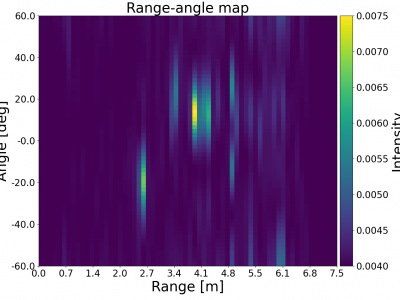Machine Learning
In our work, we propose an innovative system to accurately infer and track occluded target locations using mmWave beat frequency signals. Our approach combines a classic direction-finding method with advanced deep learning techniques, specifically a convolutional neural network (CNN), to enhance detection capabilities. The dataset includes raw beat frequency signal data from the TI IWR6843ISK rev B with TI mmWAVEICBOOST and the TI DCA1000EVM capture board. Corresponding ground truth data (target position) from the Realsense L515 RGB-D camera is also provided.
- Categories:
 360 Views
360 ViewsAs with most AI methods, a 3D deep neural network needs to be trained to properly interpret its input data. More specifically, training a network for monocular 3D point cloud reconstruction requires a large set of recognized high-quality data which can be challenging to obtain. Hence, this dataset contains the image of a known object alongside its corresponding 3D point cloud representation. To collect a large number of categorized 3D objects, we use the ShapeNetCore (https://shapenet.org) dataset.
- Categories:
 655 Views
655 Views
The dataset exemplifies land vehicle targets, tanks, and comprises 1000 time-frequency representation (TFR) images in jpg format with a resolution of 875x656 pixels. Each image is accompanied by labels containing 14 parameters for geometric parameter prediction.
- Categories:
 86 Views
86 ViewsThe advancement of machine and deep learning methods in traffic sign detection is critical for improving road safety and developing intelligent transportation systems. However, the scarcity of a comprehensive and publicly available dataset on Indian traffic has been a significant challenge for researchers in this field. To reduce this gap, we introduced the Indian Road Traffic Sign Detection dataset (IRTSD-Datasetv1), which captures real-world images across diverse conditions.
- Categories:
 1134 Views
1134 ViewsThis dataset contains the measurement in an ultrawide band (UWB) system in the 6.5 GHz band, considering the presence of the human body as the only obstacle. There are measurements in line-of-sight condition to compare the results of the analysis performed. The measurements are part of our research on the adverse effects of the body shadowing in pedestrian localization systems. The measurements were obtained in three distinct scenarios.
- Categories:
 790 Views
790 ViewsThe dataset created focuses on the Pakistan Military by collecting five types of entities from Wikipedia: weapons, ranks, dates, operations, and locations. An open-source NER annotator was utilized for annotation, ensuring accurate labeling of data. Post-annotation, the data underwent cleaning and balancing processes. The final dataset comprises 660 neutral and 660 anti-military sentiment samples, totaling 1320 samples. This balanced dataset serves as a valuable resource for sentiment analysis, providing insights into public sentiment regarding military-related topics.
- Categories:
 431 Views
431 ViewsThe dataset includes Pakistan most popular YouTube videos for each category from year 2021- 2023. There are two kinds of data files, one includes video statistics and other one related to comments on those videos. They are linked by the unique video_id field. Both datasets are merged in final videos file which contains all videos statistics and sentiment extracted from comments. Here’s a breakdown of each column:
- Categories:
 299 Views
299 ViewsThe detection of anomalous structures in natural image data is of utmost importance for numerous tasks in the field of computer vision. The development of methods for unsupervised anomaly detection requires data on which to train and evaluate new approaches and ideas. We introduce the MVTec Anomaly Detection (MVTec AD) dataset containing 5354 high-resolution color images of different object and texture categories. It contains normal, i.e., defect-free, images intended for training and images with anomalies intended for testing.
- Categories:
 188 Views
188 ViewsAccording to US NOAA, unexploded ordnances (UXO) are ”explosive weapons such as bombs, bullets, shells, grenades, mines, etc. that did not explode when they were employed and still pose a risk of detonation”. UXOs are among the most dangerous, threats to human life, environment and wildlife protection as well as economic development. The risks associated with UXOs do not discriminate based on age, gender, or occupation, posing a danger to anyone unfortunate enough to encounter them.
- Categories:
 1311 Views
1311 Views







